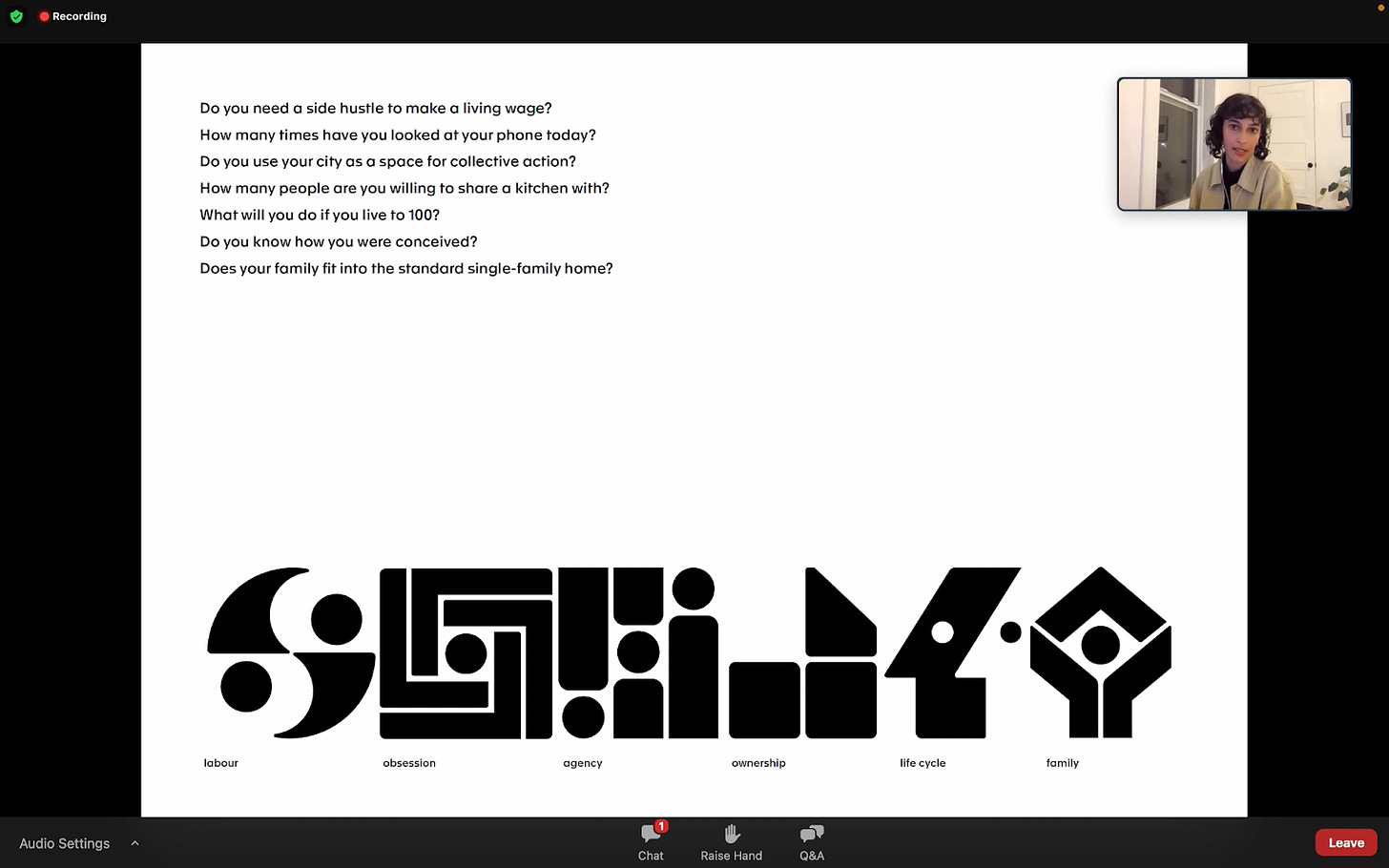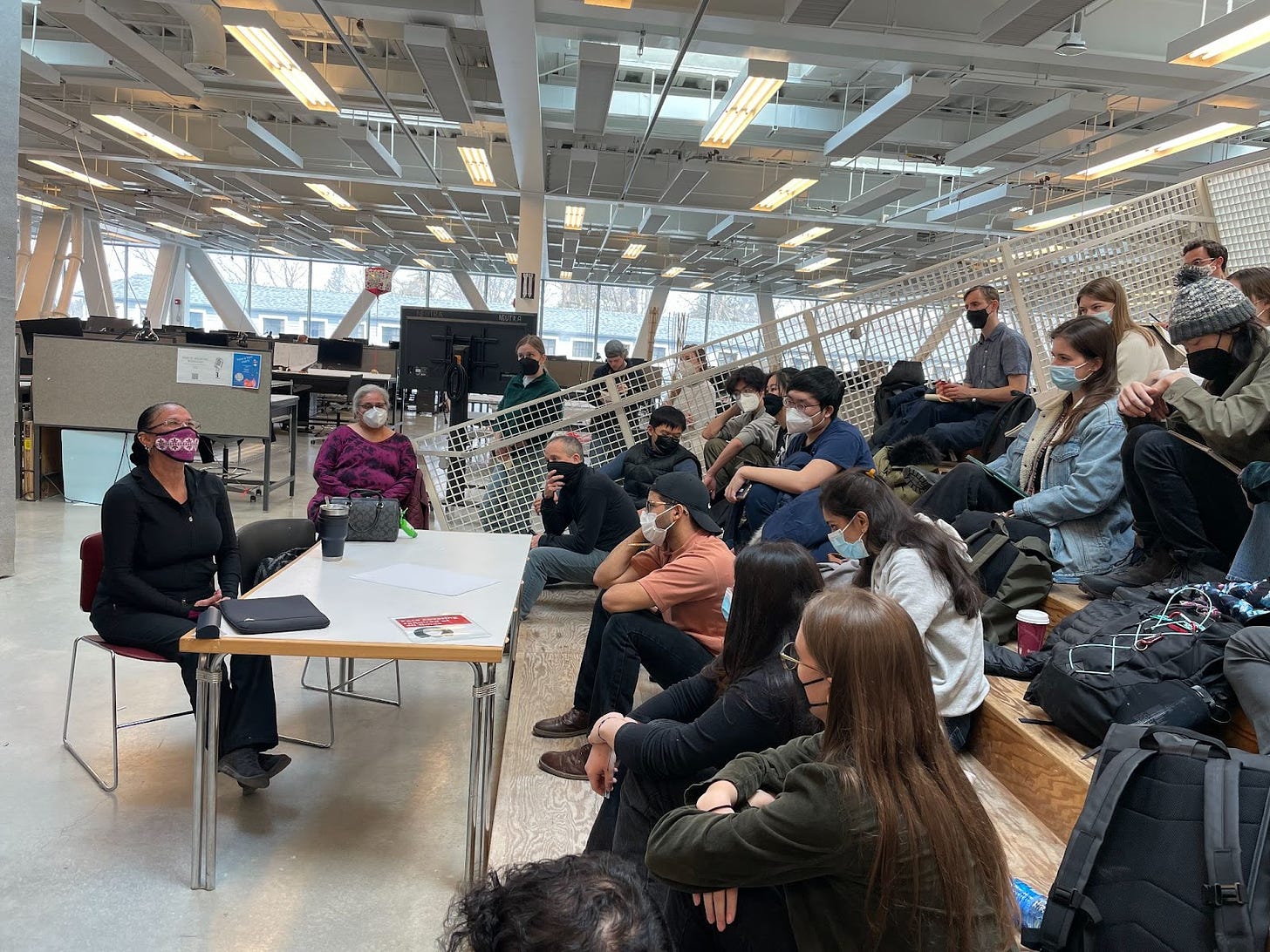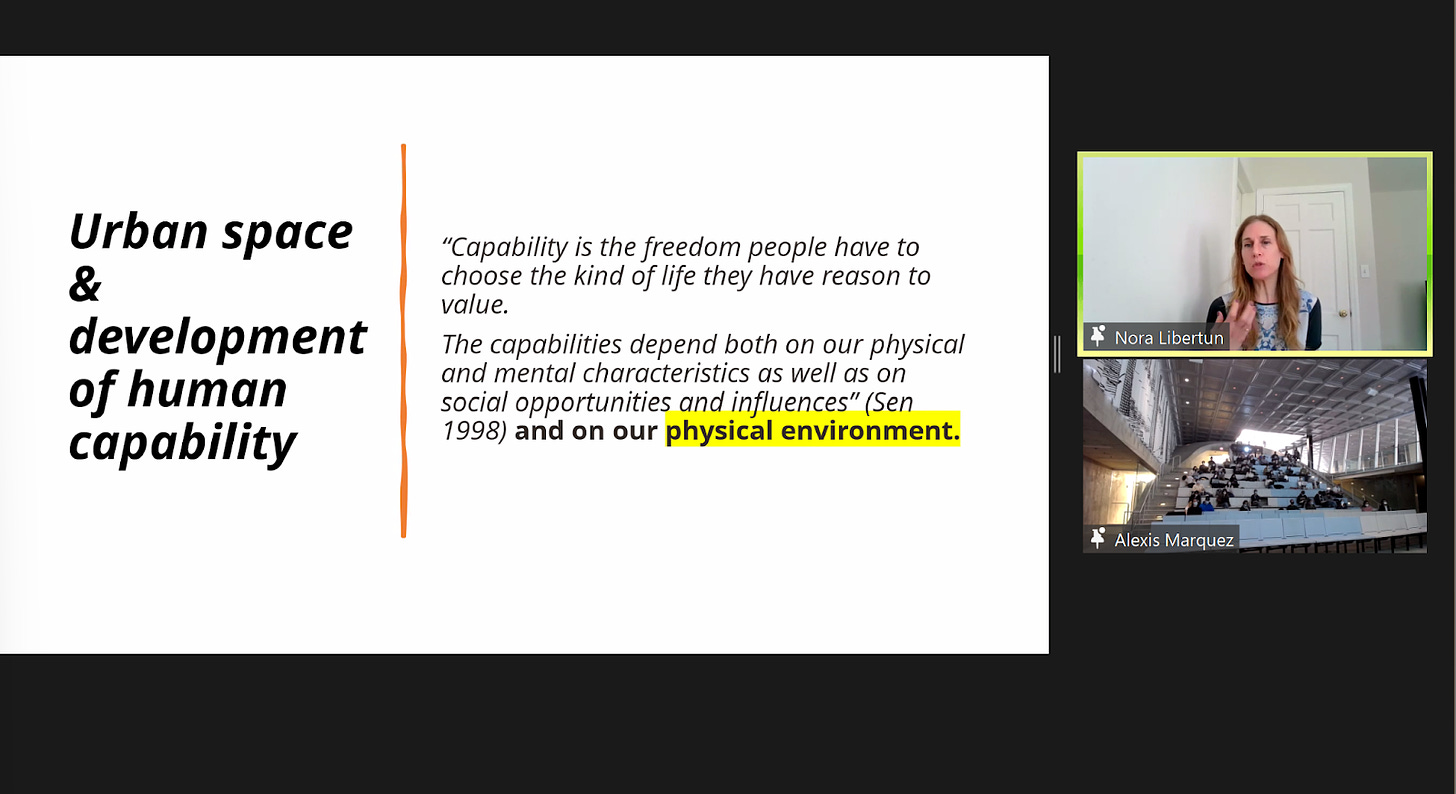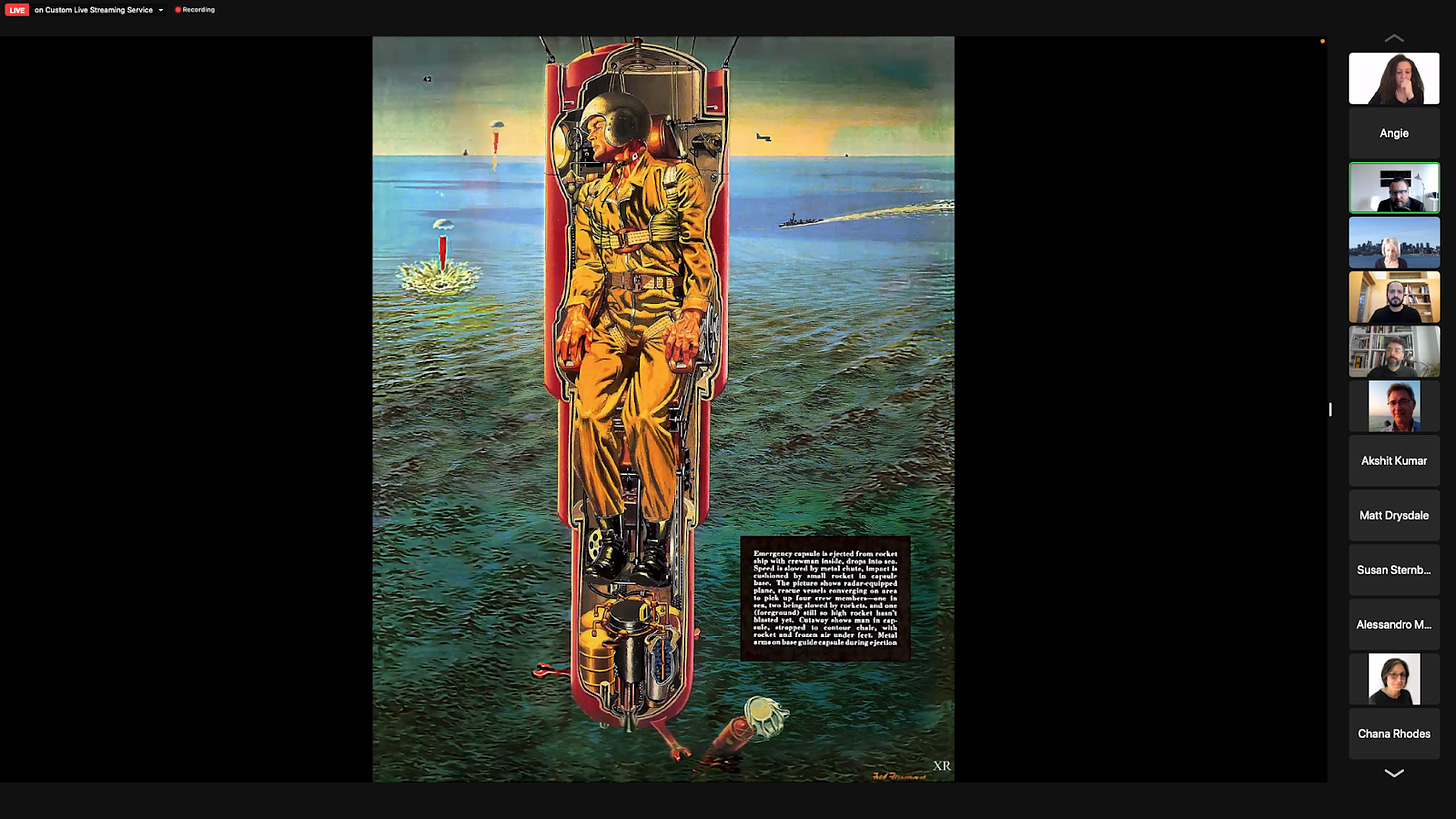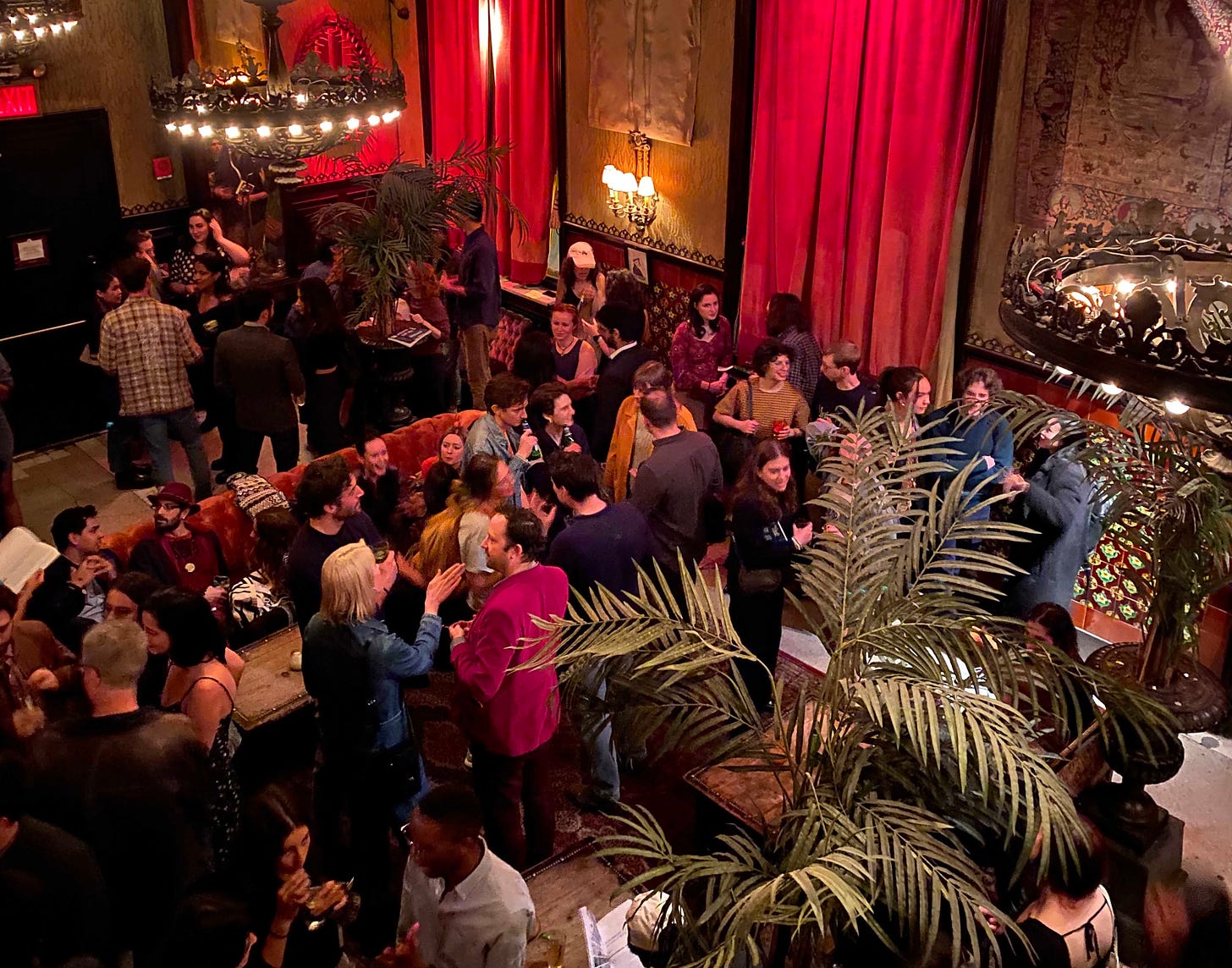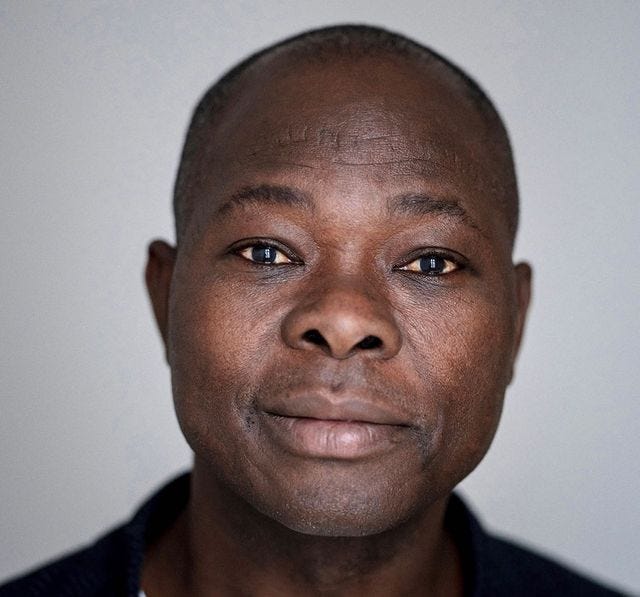Issue 61. Don’t forget to fill out your 2022 NYRA Print Reader Survey! Not yet a print reader? Awkward. Fix that right here.
Last year, architectural historian and critic Mario Carpo told PLAT 10 that in 1976, as a student in Italy, he reckoned the relationship of architecture to society had three general directions: The Marxists believed that changing architecture was predicated on a change in society; the revisionists sought to express anti-capitalist values through capitalist architecture; and a third group subscribed to what Carpo calls a "Tafurian compromise," the belief that architects should stop making buildings, study history, and wait for better times.
If the paths for action in our time are not as clear-cut, the events gathered for this week’s Skyline point to a growing insistence in thinking of disciplinary modes of action that, to borrow from Stefan Novakovic’s op-ed, reside far beyond the drafting table.
But asking what architecture can do precipitates a useful inversion; and the question of what architecture cannot do—far from signifying defeat or retrenchment—opens a window on what we can do collectively.
— Sebastián López Cardozo
Far Beyond the Drafting Table
When the 2021 Venice Biennale of Architecture finally opened last May, it felt more than a year too late. Organized around the question of How will we live together?, biennale curator Hashim Sarkis framed the postponed showcase as the fulcrum of a “new spatial contract” in a world of “widening political divides and growing economic inequalities.” While Sarkis’ manifesto offered compelling paeans to harsh realities, the postponed showcase also re-treaded an academic discourse still gripped by conceptual provocations and theoretical indulgence, paired with a requisite dose of utopian architectural solutions.
Only a few months after the biennale wrapped up in November, the COVID-scarred world’s attention shifted again. As the Russian invasion of Ukraine dominates the headlines, allegories for the anthropocene and an ambitious dream to solve food security through micro-algae already feel like a relic of another era. What to make of it all? From Yemen to Ukraine and Ethiopia, answers for How will we live together? lie far beyond the academy or the drafting table—if they can be found at all. If nothing else, it is a world better understood as a human being than a designer. Then again, I never actually went to Venice.
— Stefan Novakovic
DISPATCHES
3/10: Streets as Places for Climate Action and Equity
International Streets: Combatting Emissions in Medellín at the Urban Design Workshop
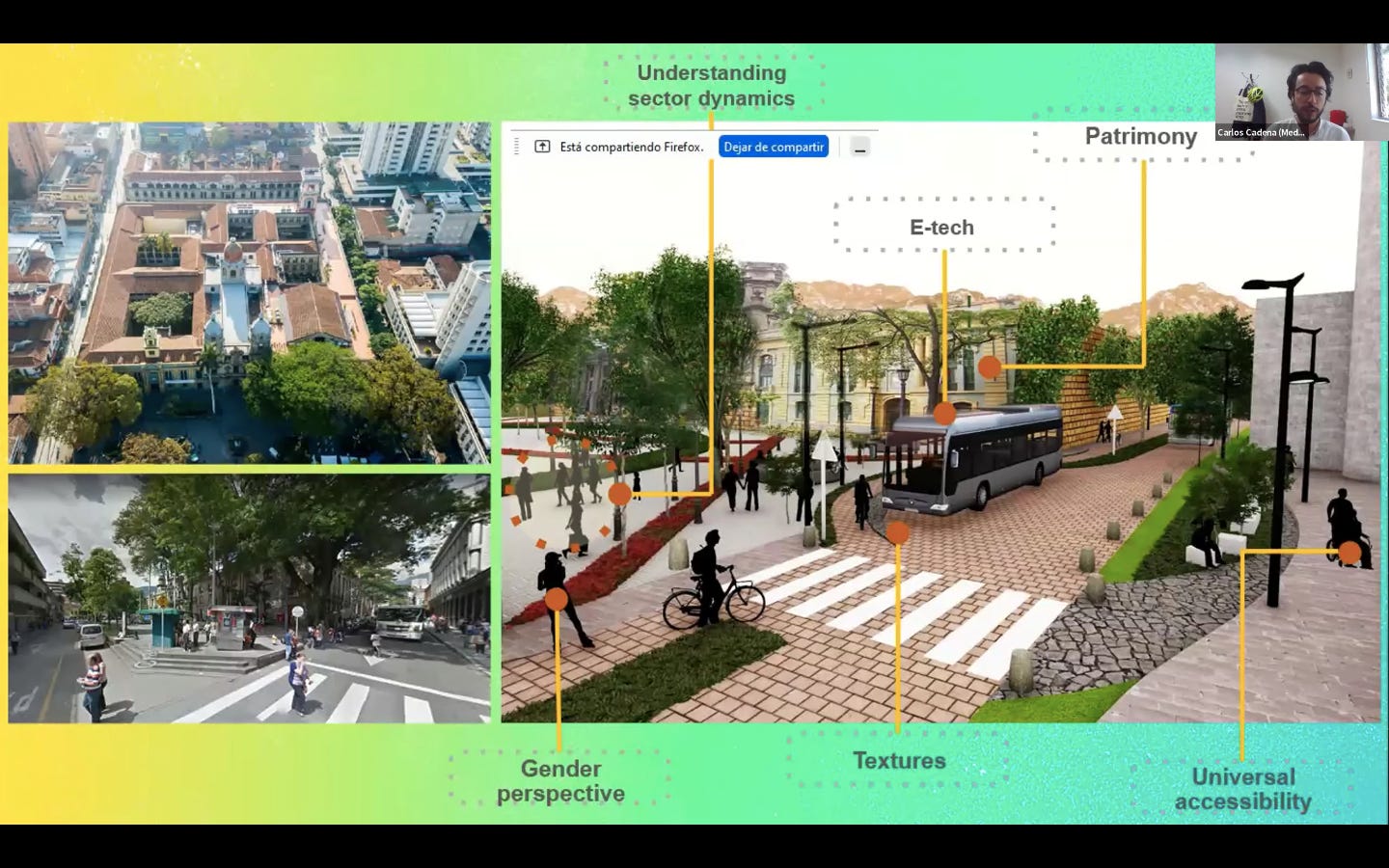
NEW YORK (ZOOM) — CARLOS CADENA-GAITÁN, Assistant Professor at EAFIT University in Medellín, was joined by LOUISE YEUNG, Chief Climate Officer at the NYC Comptroller’s Office, and SHACHI PANDEY, founding principal of Metropolitan Urban Design Workshop, for a discussion about the role of streets in mitigating the effects of climate change.
Medellín’s Zona Urbana de Aire Protegido (low-emission zone), which Cadena-Gaitán introduced during his time as the city’s Transport Secretary in 2020-2021, establishes a wide-ranging set of measures to combat emissions and create people-centric streets. The low-emission program, Cadena-Gaitán noted, was accompanied by an increase of female cyclists—a 300% increase over the period of one year. In discussing street safety and access, Yeung noted the significance of “connecting the work around streetscape design to gender,” particularly in the context of a rise in “violence against Asian women in public spaces.”
Partnerships among agencies, funding, governance, and political will, panelists agreed, are crucial if we want to transform streets and combat the multiple crises that confront our cities.
— Poun Laura Kim
3/10: Escaping Judgment Mode
Marianela D’Aprile at the Farrell Centre
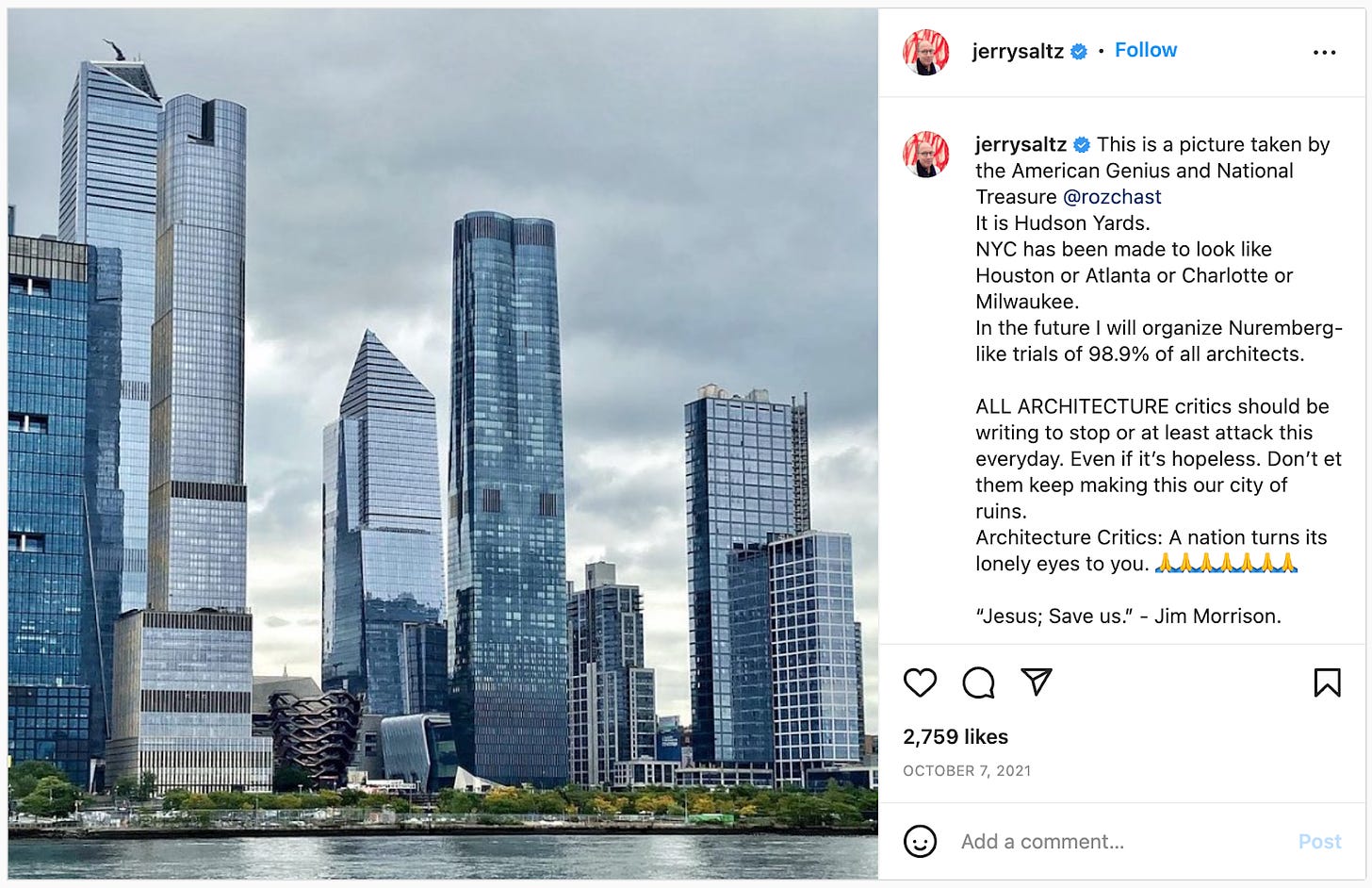
NEWCASTLE, UK (ZOOM) — “How do we get beyond judgment mode?” Speaking to a small and engaged lunchtime zoom audience gathered by architectural writer and curator OWEN HOPKINS of the Farrell Centre last Thursday as a part of their Towards Another Architecture series, architecture critic MARIANELA D’APRILE (with whom I work at NYRA) rebutted a hot take by New York Magazine’s senior art critic JERRY SALTZ, about holding Nuremberg Trials for architects. In its place, she offered her own hot take on the state of architecture, saying: "I don't think architecture critics can stop bad buildings, especially after they are made."
D’Aprile posited that there are two main modes of critique today: (1) Rewriting the press release, and (2) judgment. Of the two, she argued, judgment mode is not appropriate for architecture. Unlike, say, films or books, people have very little choice about which architecture they consume, “I am in my apartment right now because I live here, not because I like the architecture.”
The argument picked up a line of reasoning D’Aprile has advanced before: that buildings are products of forces much more fundamental than the architect’s pen (or the critic's opinion), namely capital and the way we organize society. Therefore she advocated that architecture critics look at buildings as something that people interact with incidentally as part of their everyday life, with the implication being that critics look at the whole system, that is, everyday life, in order to critique a building. In short, Saltz’s Hudson Yards Nuremberg trials are “going to take in a lot more people than just architecture critics..."
— Nicolas Kemper
3/10: Networks That Bind Us
Emerging Voices: Borderless Studio and Felecia Davis at the Architectural League of New York
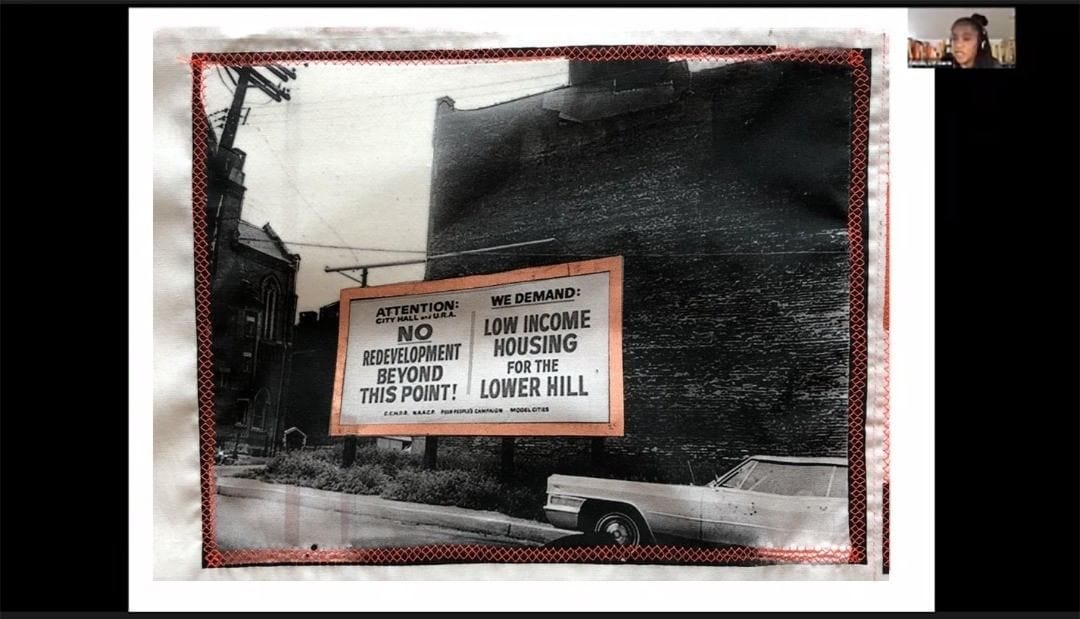
NEW YORK (ZOOM) — "In order to thrive, a community can't keep facing destruction," exclaimed Jade Foreman, a resident and artist of Chicago's Southside, in a video produced by PAOLA AGUIRRE SERRANO and DENNIS MILAM of Borderless Studio. The video displayed by the architects, titled “Climate and Cultural Resilience in Chicago’s Southside,” describes the collaborative involvement of the studio in a community-based initiative to catalog and pursue participatory activation of 45 former school sites—which had been forced to close as a result of regressive civic monetary policy.
In the following presentation, FELECIA DAVIS told stories of Black communities through computational textiles. Working at the scale of a touch, Davis illustrated the employment of copper plates to activate recordings, "integrating fragments of the past" into photographs "to construct a future." Delving further into her work on display at MoMA, Davis added that electromagnetic transmissions, made audible through textiles, operate as a “reminder of an invisible space," urging a recognition of the very real, unseen consequences of technological redlining and other discriminatory structures hidden in culture and architecture.
— Daniel Lewycky
3/10: Pull Apart to Produce Anew
A Section of Now, Book Launch with Giovanna Borasi at the Canadian Centre for Architecture
MONTREAL (ZOOM) — "Think about spaces that don't exist yet, but that we think society will need in the future." This was how GIOVANNA BORASI, director of the Canadian Centre for Architecture (CCA), opened the launch of A Section of Now, a new book she spearheaded (and which accompanies an exhibition of the same name at the institution). Framed as an interrogation into “our new lived realities,” the book features a variety of contributors with a broad socio-investigative scope—examining the future implications of everything from non-domestic workers to family recomposition and even death. Two contributors, HILARY SAMPLE and FLORIAN IDENBURG (architects and co-founders of MOS and SO – IL, respectively), joined Borasi in conversation at the launch, which was moderated by CCA editor ALEXANDRA PEREIRA-EDWARDS.
Much of the discussion centered around the notion of what role the architect will play (and how effective they will be) in producing new spaces for a new future. “A type can open up so many questions to reflect upon, around issues that are broader than architecture,” said Sample. “Perhaps,” she continued, “moving away from type can be quite radical” in freeing up space for new approaches and ideas. Through a lens of clinical spaces, Sample stressed the need for a greater level of humanity and empathy in design, rather than defaulting to efficient or cost-effective models.
Ultimately, the panelists agreed that the role of architects is to find and introduce nuance to address the complexities of our living, rather than just reacting to what comes in their path. Though current models of architecture stem from a functional modernism where programs and typologies are often rigid and codified, the only means of anticipating spaces for the future lies in resisting and questioning these notions. As Sample put it: “As architects, where can we find space to insert things and push?”
— Harish Krishnamoorthy
3/11: You Never Know What a Single Seed Can Turn Into
Braiding the Sacred, on Haudenosaunee Food Sovereignty at Cornell AAP
ITHACA, NY (ZOOM) — During a talk for Visiting Associate Professor ANNA DIETZSCH's Cornell AAP option studio ForestCity: Salamanca, ANGELA FERGUSON, a member of the Onondaga Nation Eel Clan, spoke about what the concept of food sovereignty has evolved into in the Haudenosaunee community.
Ferguson spoke in depth about the Onondaga Nation Farm, which she supervises. She described its importance in sustaining the community through the planting of diverse seeds. As time has gone by, she explained, the goal has become maximizing the amount of nutritional sustenance that can be extracted from the smallest amount of land. The project has grown considerably since its inception. According to Ferguson, from the original small plot, it has grown to cover 13 to 15 acres of land. The initiative has since inspired 98 other gardens in fellow nations.
Seeds are honored even before they grow in the community. Ferguson mentioned the all-Indigenous group she helped initiate, Braiding the Sacred. It speaks to the philosophy of rematriation: the work of returning the sacred seeds (some thousands of years old) to their ancestral land. They are collected and stored and eventually planted using traditional corn-growing techniques, she explained. Equally importantly to Ferguson, the initiative encourages the unification of clan members of all ages. It is her hope to continue to see people find their ideal spot in the “chain” and to be of service to the community as a whole.
— Nouran Abdelhamid
3/11: Myths and Lessons from the Global South
3x3x3-Myths, Challenges, and Opportunities for Inclusive Cities in the Global South at Cornell AAP
ITHACA, NY (ZOOM) — As we consider questions of inclusivity within and across political borders now more than ever, Dr. NORA LIBERTUN DE DUREN’s lecture at Cornell AAP provided a timely and comprehensive understanding of the socio-spatial inequalities found in slums in cities of the Global South, and presented ideas in favor of more inclusive cities.
Libertun de Duren—a sustainability, social inclusion, and affordable housing expert—explained that informal settlements are closely tied with migration. Slums commonly host people who have migrated not from rural areas, but from other urban areas, often due to violence (i.e. refugees): “When that happens, what you have is an expulsion, and people look to an area not because the area is providing them [with] opportunities in particular [...] but because they need to.” She stressed that when people migrate to escape violence, there is little infrastructure or framework to support them, which makes integration more difficult.
Libertun de Duren also addressed myths regarding slums: “It’s not that people cannot afford a housing unit; it’s that they cannot afford a housing unit where they need it.” She argued that it may actually be more cost-efficient to invest in the infrastructure of slums than suburbs. This is explained by the high cost of providing resources to sprawling suburbs, an issue that is inexistent in dense slums. Demonstrated by her lecture, Libertun de Duren does not subscribe to myths relieving the field of planning of responsibility and calls for design solutions to the socio-spatial inequities and injustices in question.
— Randa Omar
3/16: Through the Eyes of Creatures and Specters
Territories of Planetary Urbanization at NYIT
NEW YORK (ZOOM) — Moderated by NYIT’s Urban Design director MARCELLA DEL SIGNORE, a series of talks on Territories of Planetary Urbanization took the audience around the globe through the eyes of various creatures and specters. JEFFREY S. NESBIT discussed how mid-century U.S. aerospace designs and their oceanic test sites expanded notions of territory, both along national boundaries and in the collective imaginary. The territories of the continent's mega-regions were put in conversation with the micro-evolutions of their seeds, spiders, and foxes by MARINA ALBERTI, who recommended that we (humans) look to the recursive actions of nature as we design for urban resilience. ALI FARD took us to the hinterland by mapping technology conglomerates through the strata of their "(data) farms, pipes, mines, and enclaves.” The geography of these technology centers, Fard noted, often fills voids left by industrial ghosts, taking advantage of aging but existent infrastructure while often reneging on their local investment promises. In the Q&A, planetary urbanism was described as a mode that reveals "uneven geographies" and their proxy networks of power. In this context, the revelatory can turn reparative: Designers can redirect vast questions of resilience onto the micro-territories of urban seedlings and aging pipes.
— Angie Door
EYES ON SKYLINE
In Skyline 60, readers waited eagerly for the 2022 Pritzker Prize announcement, and were curious about BIG’s new metaverse endeavors.
NYRA ON THE TOWN
Exhibitions, parties, and other IRL delights
Drifting Through the Six
Launch Party at the Jane Hotel
The editors and contributors of The Drift know that young people want clarity among the chaos and general “confusion of contemporary life in America.” Or at least, that was how JACKSON ARN, who penned an essay for the new issue, described American life at the magazine’s Issue Six launch party.
On weeknights, I usually scroll through social media, share memes and reels, and abandon myself to a decadent feeling of apathy towards politics, work, culture, planning, art, and design. But last Tuesday, I put on a Ganni dress, strolled up the West Side highway alongside the joggers, stood in line, and got myself a French-75 at the Jane Hotel. I drifted across the room to hear emerging writers read their work, and observed as they shuffled through and made sense of the paradoxes and folly of the American experience.
Once inside the hotel, I listened to issue editors REBECCA PANOVKA and KIARA BARROW as they called on readers (and party attendees) to take a serious stance toward the present moment. “The crisis of modern feminism” and “ethnically ambigious beauty standards” surfaced as topics of discussion. To deal with contemporary life (in America), taking risks, and doing so with rigor, the editors said, is crucial.
By gathering us in a room, we were able to see, hear, and potentially have a conversation with the writers. We usually have to stalk bios, websites and Twitter handles (a grueling task) to get a sense of who we are reading, looking for red flags and the potential for trust. At the hotel, below the disco balls and chandeliers, chunky boots and strappy dresses saved us some browsing time.
Reading a literary magazine is often overwhelming; a solo endeavor. One page in and you see over fifteen names and a flood of perspectives to come, a journey in-and-out of multiple minds. This event’s brief introductions and series of readings made the issue approachable and digestible. It gave a sense of which pieces to spend time with.
Highlights of the readings included: Jamie Hood’s “The Girlboss and the Anti-Woke Cool Girl,” a critique of the failure to imagine and dream up feminist futures; James Yeh’s “Untranslatability,” which delves into the anxieties of our digital lives; and “A History of Pigs in America” by Hannah Kauders, an exploration of love, pain, and friendship in a compelling Bushwick-based narrative.
Attendees were respectfully still and sympathetic as authors read their work, but the energy was explosively released shortly thereafter. Eager to meet someone new or talk about their work, the crowd filled the room and mingled. With only four bar-tenders, the hotel was not prepared for the buzz. For those over thirty, the night was short. Spilling down the Jane Hotel’s historic staircases and out into the meatpacking district, the irony of the night was palpable: A night meant to push dialogue in a critical direction had as its backdrop an icon of dominant hegemonic culture.
The final reading was a poem by Daniel Poppick titled “Nothing Like the Sun,” which explores the idea of clarity. In the midst of existential confusion and disorder, Poppick’s poem left me with a sense of peace. As we move forward, there may be a clear window or a dirty window, or maybe no window to look out at all.
— Michelle Mueller Gámez
IN THE NEWS
The Eiffel Tower gains 20 feet thanks to a helicopter-applied communications antenna…
WoodWorks reveals 2022 winners of U.S. Wood Design Awards…
Mexican architect Frida Escobedo will lead the Met’s Modern and Contemporary Wing renovation…
New York State asked for $1.6 billion in rent relief. It received just $119 million…
— Anna Gibertini
OPPORTUNITIES
NEW CITY CRITICS. Urban Omnibus / The Architectural League of New York and Urban Design Forum are starting a fellowship program to empower new, fearless, and diverse voices to challenge the ways we understand, design, and develop our cities. Fellows will be awarded a stipend of $15,000 for participation in the 18-month fellowship. In addition, they will be provided a travel or research stipend of $2,000 and an allowance of up to $2,500 for project expenses. Deadline is March 23, information session is February 28. Information here.
DATELINE
The week ahead…
Monday, 3/21
Baumer Lecture, The Possibilities of Infrastructure with Deborah Cowen
5:30 PM | Ohio State University Knowlton School of Architecture
Lecture with Andrea Fraser, Felicity D. Scott, Mark Wasiuta
6:30 PM | Columbia Graduate School of Architecture Planning and Preservation
3D Turntables with Sekou Cooke
9:00 PM | SCI-Arc
Tuesday, 3/22
FDN Talk with Anoka Faruqee and Odili Donald Odita
12:30 PM | Pratt Institute
Design and Technology Cloud Salon with Tamiko Thiel
3:00 PM | The New School, Parsons School of Design
Philadelphia City Planning Commission with Eleanor Sharpe
4:00 PM | Morgan State University SA+P
Wednesday, 3/23
Race, Space and Architecture: Reflections on a Curriculum with Suzi Hall, Huda Tayob, Thandi Loewenson, Emanuel Admassu
12:00 PM | Columbia University GSAPP
A Conversation with Harry Allen and Jay Smooth
6:00 PM | Pratt Institute
Roundtable | Under Pressure: Urban Housing and Other Hybrids with Brian Phillips, Scott Erdy, Laia Mogas-Soldevila, Nader Tehrani
6:00 PM | Cooper Union
Thursday, 3/24
The Untold: Finding Ancestors of Color in the Built Environment with Tara Dudley
6:00 PM | Spitzer School of Architecture
Emerging Voices: Estudio MMX and Landing Studio with Jorge Arvizu, Ignacio del Río, Emmanuel Ramírez, Diego Ricalde, Daniel Adams, Mariel Law Adams
6:30 PM | The Architectural League of New York
Bringing Digitalization Home: How Can Technology Address Housing Challenges? with Molly Wright Steenson
6:30 PM | Harvard Graduate School of Design
Friday, 3/25
Community Centered Slum Upgrading: Lessons from Mukuru Special Planning Area Project, Nairobi with Joe Muturi
12:25 PM | Cornell Architecture Art Planning
Design for All with Don Hickman
1:00 PM | Rice University
Cocktails & Conversation with Moshe Safdie, Donald Albrecht
6:30 PM | American Institute of Architects New York
Our listings are constantly being updated. Check the events page regularly for up-to-date listings and submit events through this link.
LETTERS TO THE EDITOR
Would you like to share your thoughts? Send them on over! Simply reply to this email or write to us at editor@nyra.nyc.
Four desk editors run NYRA: Alex Klimoski, Phillip Denny, Carolyn Bailey & Nicolas Kemper (who also serves as the publisher).
To pitch us an article or ask us a question, write to us at: editor@nyra.nyc.
For their support, we would like to thank the Graham Foundation and our issue sponsors, Tod Williams Billie Tsien Architects and Thomas Phifer.
To support our contributors and receive the Review by post, subscribe here.




